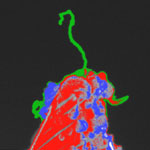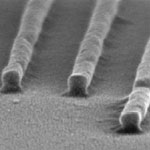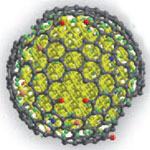Showing Spotlights 1753 - 1760 of 2782 in category All (newest first):
 Understanding the behavior and impacts of nanomaterials in the environment and in human health is a daunting task. Today, we don't even know what the impact of most chemicals is, and that includes products we have been using for many years. Nevertheless, a general understanding about nanotoxicity is slowly emerging as the body of research on cytotoxicity, genotoxicity, and ecotoxicity of nanomaterials grows. Many of the published toxicity studies have limited relevance, due, in large part, to study design limitations, including inadequate justification for dose selection or route of exposure criteria. A recently published article addresses myths and misconceptions regarding nanotoxicology.
Understanding the behavior and impacts of nanomaterials in the environment and in human health is a daunting task. Today, we don't even know what the impact of most chemicals is, and that includes products we have been using for many years. Nevertheless, a general understanding about nanotoxicity is slowly emerging as the body of research on cytotoxicity, genotoxicity, and ecotoxicity of nanomaterials grows. Many of the published toxicity studies have limited relevance, due, in large part, to study design limitations, including inadequate justification for dose selection or route of exposure criteria. A recently published article addresses myths and misconceptions regarding nanotoxicology.
Nov 2nd, 2010
 Compared to silicon-based devices, polymer solar cells made of conducting plastic material are lightweight, relatively inexpensive to fabricate, flexible, designable on the molecular level, and have little potential for negative environmental impact. The big question today is to what degree polymer solar cells will be able to commercially compete with silicon solar cells. With the exciting vision of organic solar cells becoming a low-cost electricity source available in any size and shape, as flexible thin films and even coatings, researchers all over the world are working on making organic solar cells commercially attractive. Finding a relatively simple way of polymerizing fullerenes and including this new material in photovoltaic cells, researchers have opened a route towards plastic solar cells that are much cheaper and easier to fabricate than conventional silicon-based photovoltaic panels.
Compared to silicon-based devices, polymer solar cells made of conducting plastic material are lightweight, relatively inexpensive to fabricate, flexible, designable on the molecular level, and have little potential for negative environmental impact. The big question today is to what degree polymer solar cells will be able to commercially compete with silicon solar cells. With the exciting vision of organic solar cells becoming a low-cost electricity source available in any size and shape, as flexible thin films and even coatings, researchers all over the world are working on making organic solar cells commercially attractive. Finding a relatively simple way of polymerizing fullerenes and including this new material in photovoltaic cells, researchers have opened a route towards plastic solar cells that are much cheaper and easier to fabricate than conventional silicon-based photovoltaic panels.
Nov 1st, 2010
 A relatively new method of purifying brackish water is capacitive deionization (CDI) technology. The advantages of CDI are that it has no secondary pollution, is cost-effective and energy efficient. The basic concept of CDI, as well as electrosorption, is to force charged ions toward oppositely polarized electrodes through imposing a direct electric field: brackish water flows between pairs of high surface area carbon electrodes that are held at a potential difference of about 1-2 volts. The ions and other charged particles, such as microorganisms, are attracted to and held on the electrode of opposite charge. A research team has now developed a CDI application that uses graphene-like nanoflakes as electrodes for capacitive deionization. They found that the graphene electrodes resulted in a better CDI performance than the conventionally used activated carbon materials.
A relatively new method of purifying brackish water is capacitive deionization (CDI) technology. The advantages of CDI are that it has no secondary pollution, is cost-effective and energy efficient. The basic concept of CDI, as well as electrosorption, is to force charged ions toward oppositely polarized electrodes through imposing a direct electric field: brackish water flows between pairs of high surface area carbon electrodes that are held at a potential difference of about 1-2 volts. The ions and other charged particles, such as microorganisms, are attracted to and held on the electrode of opposite charge. A research team has now developed a CDI application that uses graphene-like nanoflakes as electrodes for capacitive deionization. They found that the graphene electrodes resulted in a better CDI performance than the conventionally used activated carbon materials.
Oct 27th, 2010
 In atomic force microscopy (AFM), tip quality depends mainly on the dimensions and shape of the probe, the durability of the tip apex, and the nature of the interaction between sample and probe. With this in mind, researchers have experimented with mounting ultra sharp and high aspect ratio carbon nanotube (CNT) bundles onto the apex of an AFM tip to improve spatial and potential resolution. Although AFM tips functionalized with a carbon nanotube have attracted considerable attention, attaching CNTs to scanning probes is not a trivial matter, which limits their practical use. An alternative approach, whereby a CNT is grown onto the AFM tip, also can be very time-consuming and requires a costly set-up. A team at the Friedrich-Schiller-University Jena in Germany has now demonstrated a fast and cheap process for the fabrication of carbon nanotube AFM tips with the help of microwave ovens.
In atomic force microscopy (AFM), tip quality depends mainly on the dimensions and shape of the probe, the durability of the tip apex, and the nature of the interaction between sample and probe. With this in mind, researchers have experimented with mounting ultra sharp and high aspect ratio carbon nanotube (CNT) bundles onto the apex of an AFM tip to improve spatial and potential resolution. Although AFM tips functionalized with a carbon nanotube have attracted considerable attention, attaching CNTs to scanning probes is not a trivial matter, which limits their practical use. An alternative approach, whereby a CNT is grown onto the AFM tip, also can be very time-consuming and requires a costly set-up. A team at the Friedrich-Schiller-University Jena in Germany has now demonstrated a fast and cheap process for the fabrication of carbon nanotube AFM tips with the help of microwave ovens.
Oct 26th, 2010
 Medical researchers believe that the best way to protect eye from glaucoma is to protect the optic nerve from a sudden increase in intraocular pressure since ocular hypertension is the most important risk factor for glaucoma. Accordingly, for the past few years, huge research efforts have been made to develop a powerful biotechnical approach to protect the optic nerve. As a result, scientists discovered that Heat Shock Proteins (HSPs) can be a new powerful modality for the protection of optic nerves - ocular neuroprotection - from glaucoma. Although a variety of methods to induce HSPs have been developed and tried, they all were found to be ineffective for the induction of HSPs from the optic nerve due to side effects including chemical and physical side effects. A novel nanomedicine modality has now been shown to be feasible for ocular neuroprotection in glaucoma cases.
Medical researchers believe that the best way to protect eye from glaucoma is to protect the optic nerve from a sudden increase in intraocular pressure since ocular hypertension is the most important risk factor for glaucoma. Accordingly, for the past few years, huge research efforts have been made to develop a powerful biotechnical approach to protect the optic nerve. As a result, scientists discovered that Heat Shock Proteins (HSPs) can be a new powerful modality for the protection of optic nerves - ocular neuroprotection - from glaucoma. Although a variety of methods to induce HSPs have been developed and tried, they all were found to be ineffective for the induction of HSPs from the optic nerve due to side effects including chemical and physical side effects. A novel nanomedicine modality has now been shown to be feasible for ocular neuroprotection in glaucoma cases.
Oct 25th, 2010
 Many nanotechnology research projects require some form of nanopatterning technique in fabricating the devices, structures and surfaces required. With the current state of micro- and nanofabrication, the direct printing of functional materials is the most efficient method at low cost and low environmental impact. A direct printing approach has the merits of forgoing complex and expensive equipment, reducing the fabrication processes, saving the amount of material used, and removing chemical exposure in the processes. However, imprinting methods suffer from residues and difficulty in multi-alignment. Researchers in Korea have now developed a direct printing technique that is based on a liquid-bridge-mediated transfer moulding process.
Many nanotechnology research projects require some form of nanopatterning technique in fabricating the devices, structures and surfaces required. With the current state of micro- and nanofabrication, the direct printing of functional materials is the most efficient method at low cost and low environmental impact. A direct printing approach has the merits of forgoing complex and expensive equipment, reducing the fabrication processes, saving the amount of material used, and removing chemical exposure in the processes. However, imprinting methods suffer from residues and difficulty in multi-alignment. Researchers in Korea have now developed a direct printing technique that is based on a liquid-bridge-mediated transfer moulding process.
Oct 20th, 2010
 Catalytic dehydrogenation of ethylbenzene is one of the most important processes in the chemical industry world-wide. Styrene, for instance, is commonly produced using this process. The annual production of some 20 million metric tonnes of styrene is an important precursor in the plastics industry. Being able to develop a new metal-free, energy-saving, and efficient catalyst for alkane dehydrogenation would have a significant positive impact on the environment. Coke formation during the current industrial process is the main disadvantage of the metal-based catalysts now used. Steam is used as a protection agent to avoid coking and thus keep the catalysts active. The steam generation consumes massive amounts of energy. This is simply solved by using carbon as catalyst material. Even without steam, the catalyst is free from coke formation and shows long time stability. Researchers have now developed a new process for the dehydrogenation of ethylbenzene, using nanodiamonds as catalyst, that is oxygen-free and steam-free.
Catalytic dehydrogenation of ethylbenzene is one of the most important processes in the chemical industry world-wide. Styrene, for instance, is commonly produced using this process. The annual production of some 20 million metric tonnes of styrene is an important precursor in the plastics industry. Being able to develop a new metal-free, energy-saving, and efficient catalyst for alkane dehydrogenation would have a significant positive impact on the environment. Coke formation during the current industrial process is the main disadvantage of the metal-based catalysts now used. Steam is used as a protection agent to avoid coking and thus keep the catalysts active. The steam generation consumes massive amounts of energy. This is simply solved by using carbon as catalyst material. Even without steam, the catalyst is free from coke formation and shows long time stability. Researchers have now developed a new process for the dehydrogenation of ethylbenzene, using nanodiamonds as catalyst, that is oxygen-free and steam-free.
Oct 18th, 2010
 In order to improve throughput speed of DNA sequencing and reduce its cost, researchers are pursuing real-time solid-state DNA sequencing devices. To that end, electronic functional devices in liquid environments need to be developed, ideally utilizing the compatibility with current complementary metal oxide semiconductor (CMOS) based fabrication technology. In this regard, the combination of electronics and nanofluidics leads to the field of electrofluidics, which utilizes the electrical behaviors of fluids for solid state device applications. In order to explore the ion transport and biomolecule transport through nanochannels, researchers have now reported the fabrication of an electrofluidic platform to study the motion of single molecules, including DNA. The device's nanochannel structures were fabricated with sub-lithographic dimension through top-down based, conventional semiconductor fabrication methods.
In order to improve throughput speed of DNA sequencing and reduce its cost, researchers are pursuing real-time solid-state DNA sequencing devices. To that end, electronic functional devices in liquid environments need to be developed, ideally utilizing the compatibility with current complementary metal oxide semiconductor (CMOS) based fabrication technology. In this regard, the combination of electronics and nanofluidics leads to the field of electrofluidics, which utilizes the electrical behaviors of fluids for solid state device applications. In order to explore the ion transport and biomolecule transport through nanochannels, researchers have now reported the fabrication of an electrofluidic platform to study the motion of single molecules, including DNA. The device's nanochannel structures were fabricated with sub-lithographic dimension through top-down based, conventional semiconductor fabrication methods.
Oct 14th, 2010
 Understanding the behavior and impacts of nanomaterials in the environment and in human health is a daunting task. Today, we don't even know what the impact of most chemicals is, and that includes products we have been using for many years. Nevertheless, a general understanding about nanotoxicity is slowly emerging as the body of research on cytotoxicity, genotoxicity, and ecotoxicity of nanomaterials grows. Many of the published toxicity studies have limited relevance, due, in large part, to study design limitations, including inadequate justification for dose selection or route of exposure criteria. A recently published article addresses myths and misconceptions regarding nanotoxicology.
Understanding the behavior and impacts of nanomaterials in the environment and in human health is a daunting task. Today, we don't even know what the impact of most chemicals is, and that includes products we have been using for many years. Nevertheless, a general understanding about nanotoxicity is slowly emerging as the body of research on cytotoxicity, genotoxicity, and ecotoxicity of nanomaterials grows. Many of the published toxicity studies have limited relevance, due, in large part, to study design limitations, including inadequate justification for dose selection or route of exposure criteria. A recently published article addresses myths and misconceptions regarding nanotoxicology.
 Subscribe to our Nanotechnology Spotlight feed
Subscribe to our Nanotechnology Spotlight feed





